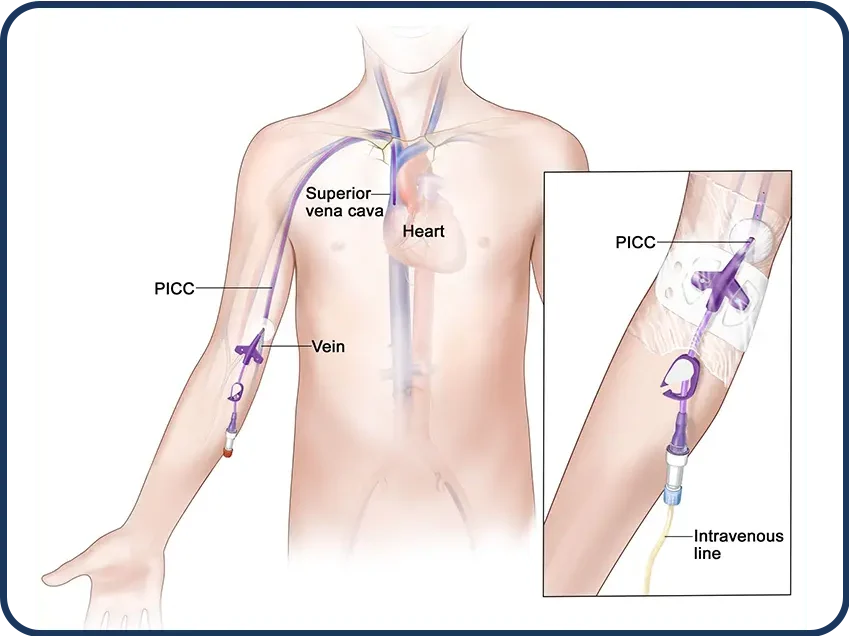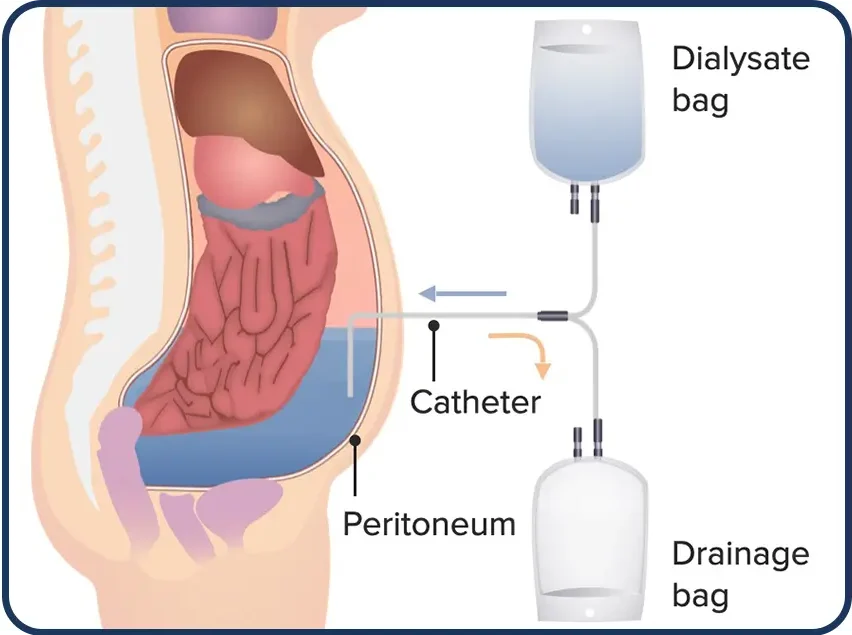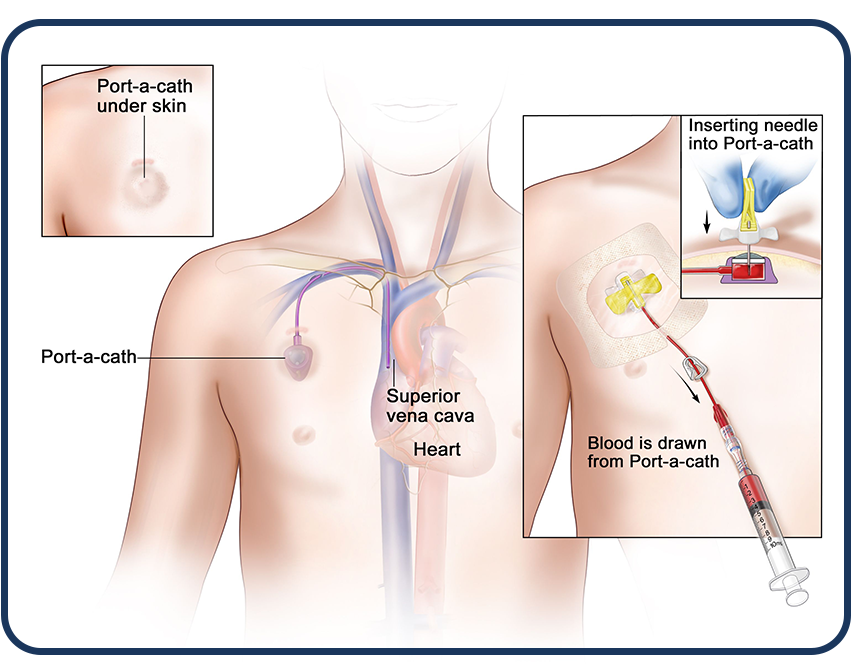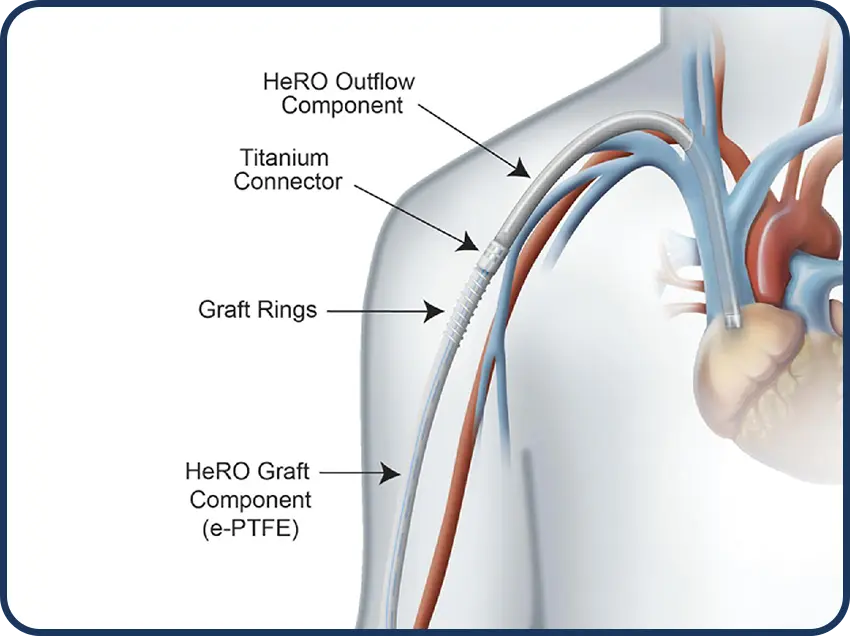Kidney Treatment
Peripherally Inserted Central Catheter (PICC Line)
What is a PICC Line?
A peripherally inserted central catheter is a narrow tube that is put into a vein in the arm, usually in the elbow area. It is used to deliver medications and other treatments directly to the larger veins near your heart.
Why this procedure is recommended?
A PICC line is placed in the standard IV (intravenous) line. A PICC line can remain inserted for an extended period of time compared to other forms of central IV access, ranging from seven days to several months as long as the line remains viable.
It is commonly recommended for:
- Cancer treatments (chemotherapy or targeted therapy drugs).
- Liquid nutrition (If your body can’t process nutrients from food because of digestive system problems, you may need a PICC line for receiving liquid nutrition).
- Infection treatments (antibiotics and antifungals).
- Other medications (Some medicines can irritate the small veins, and giving these treatments through the PICC line reduces that risk).
- Blood transfusions.

How Is This Procedure Performed?
- The procedure begins with the doctor prepping the area over your upper arm with iodine soap.
- Local anesthesia will be injected into the skin at the insertion site. You may feel some stinging at the site for a few seconds after the local anesthetic is injected.
- After the area is numb, a contrast dye is injected into the vein.
- Under ultrasound guidance, a thin needle is used to enter the vein, then a safety guidewire with a floppy safety tip is inserted through the needle into the vein.
- The needle is removed and the catheter is advanced through the vein over the guidewire to the superior vena cava.
- A final chest X-ray is performed to confirm the catheter’s tip position.
What Are The Benefits VS Risks?
We have listed down a few benefits and risks below for better understanding
Benefits
- It reduces discomfort from several needle punctures that are required for continual medications or drawing blood.
- Allows for IV infusions to include certain medications that may irritate the small vein.
- Can remain in place for an extended period of time in patients that are in a hospital setting, nursing facility, or at home.
Risks
- Bleeding may occur at the insertion site
- There is a chance for accidental puncture of an artery, nerve, or tendon can occur near the insertion site
- Infection
- Phlebitis (inflammation in a vein)
- Blood clots
- A blocked or broken PICC line
Peritoneal Dialysis (PD) Catheter
What is Peritoneal Dialysis Catheter?
Peritoneal dialysis is a way to remove waste products from your blood when your kidneys cant adequately do the job any longer.
A PD catheter is a special tube that is inserted into your abdominal cavity (space around the organs within your tummy).
Why Is This Procedure Recommended?
This procedure is recommended in a variety of cases which includes:
- Vascular access failure.
- Intolerance to hemodialysis.
- Patient preference.
- Distance from a hemodialysis center.
- Pancreatitis (inflammation of the pancreas).
- Drug poisoning.
- Children aged 0-5 years.

How is this procedure performed?
- The procedure begins with the doctor prepping the area over your abdomen with iodine soap.
- Local anesthesia will be injected into the skin at the insertion site. You may feel some stinging at the site for a few seconds after the local anesthetic is injected. After the area is numb, a contrast dye is injected.
- A small incision about 2 to 3cm in length, will be made on your skin in this area Under image guidance, the catheter will be inserted into your peritoneal cavity through this incision.
- When the catheter is in position, a small amount of fluid will be flushed through it to check if it is in the correct place.
What Are The Benefits VS Risks?
We have listed down a few benefits and risks below for better understanding
Benefits
- Better patient mobility and independence
- Simplicity of use
- Maintaining residual renal function
Risks
- Infection
- Peritonitis (inflammation of the peritoneal membrane of stomach)
- Weight gain
- Hemia (area of weakness in your abdominal muscles)
- Ineffective dialysis
Port a Cath
What is a Port a Cath?
A port-a-cath is a small device that is usually placed under the skin on the right side of the chest. It offers access to the venous system via which patients undergoing long term treatment are given nutrients and medications.
Why Is this Procedure Recommended?
A port-a-cath provides reliable vascular access for patients requiring long term treatment. It is commonly recommended for:
- Cancer treatment (chemotherapy).
- Infection (antibiotics and antifungals).
- Parenteral nutrition (intravenous administration of nutrition).
- Fluids.
- Pain management.
- Frequent transfusions of blood (or blood products).
How is this procedure performed?
- The procedure begins with the doctor prepping the area over your chest and neck with iodine soap.
- Local anesthesia will be injected into the skin at the insertion site. You may feel some stinging at the site for a few seconds after the local anesthetic is injected.
- After the area is numb, a contrast dye is injected into the vein.
- Two small incisions will be made, one at the base of the neck and the other 2-3 centimeters below the collarbone.
- Under ultrasound guidance, the catheter will be inserted into the vein in your chest and it will be tunneled under the skin to the second incision.
- The catheter is then connected to a port, which is fitted into a space created under the skin. A final chest X-ray is performed to confirm the catheter tip position.

What Are The Benefits VS Risks?
We have listed down a few benefits and risks below for better understanding
Benefits
- Easy and quick access with less pain than typical needle sticks.
- Reduction of infection risk.
- A port can remain in place for years.
Risks
- Bruising.
- Infection.
- Thrombosis (obstruction of blood due to formation of blood clot).
- Dislodgement of port or line.
- Lung puncture (rare).
Perm a cath
What is a Perm a cath?
A Perm a cath, also known as tunneled dialysis catheter, is a long hollow tube made out of polyurethane. It is used with patients who require treatment on a dialysis machine.
Why Is this Procedure Recommended?
This procedure is recommended in a variety of cases which includes:
- Regular hemodialysis to treat kidney failure in an outpatient setting.
- Route/access for plasmapheresis (a process in which the liquid part of the blood is separated from the blood cells).
- Frequent blood sampling/infusion in an outpatient setting.
- Administration of drugs and fluids during long-term treatment in very specific settings.
- Administration of caustic medications (chemotherapy) that may harm peripheral veins.
- A route for TPN (method of getting nutrition into the body through the veins) and blood products where small-bore catheters cannot be used.
How is this procedure performed?
- The procedure begins with doctor prepping the area over your neck with iodine soap.
- Local anesthesia will be injected into the skin at the insertion site. You may feel some stinging at the site for a few seconds after the local anesthetic is injected.
- After the area is numb, a contrast dye is injected into the vein.
- A small incision will be made in the lower neck. The doctor will access the jugular vein in the neck with a needle and pass a small guidewire into the vein. The guidewire will be passed to a larger blood vessel called the vena cava.
- A second incision will be made in the chest below the first incision. A tunnel will be made just under the skin between the first and second incisions.
- The flexible dialysis catheter is then passed from the second incision, through the tunnel, to the first incision site.
- The other end of the catheter will remain outside of the body, extending through the second incision.
Fibrin sheath is a common complication of tunneled dialysis catheters in which a collection of different types of dead cells and cell matrix(building blocks of cell) encases the outer wall and end hole of the catheter, which can cause catheter malfunction.


